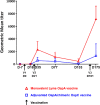Characterization of recombinant OspA in two different Borrelia vaccines with respect to immunological response and its relationship to functional parameters
- PMID: 30326885
- PMCID: PMC6191903
- DOI: 10.1186/s12917-018-1625-7
Characterization of recombinant OspA in two different Borrelia vaccines with respect to immunological response and its relationship to functional parameters
Abstract
Background: Prevention of Lyme disease in dogs in North America depends on effective vaccination against infection by the tick vector-born spirochete Borrelia burgdorferi. Most vaccines effectively prevent spirochete transmission to dogs during tick feeding based on immunization with the outer-surface lipoprotein A (OspA) of B. burgdorferi. More recently, vaccines containing additional OspC protein moieties have been introduced. These are designed to enhance protection by forming a second line of defense within the vertebrate host, where OspC expression replaces OspA as the dominant surface antigen. However, supportive data for demonstration of OspC mediated protection is still lacking. Since OspA immunogenicity is of paramount importance to protection against spirochete transmission; this study was designed to compare the immunogenicity of two commercially available vaccines against the Borrelia burgdorferi OspA. We further characterized OspA antigen fractions of these vaccines with respect to their biochemical and biophysical properties.
Results: Two groups of beagle dogs (n = 9) were administered either: (1) a nonadjuvanted/monovalent, recombinant OspA vaccine (Recombitek® Lyme) or (2) an adjuvanted, recombinant OspA /OspC chimeric fusion vaccine (Vanguard® crLyme). The onset of the anti-OspA antibody response elicited by the nonadjuvanted/monovalent OspA vaccine was significantly earlier than that for the bivalent OspA /OspC vaccine and serum borreliacidal activity was significantly greater at all post-vaccination time points. As expected, only dogs inoculated with the bivalent OspA/OspC vaccine mounted a humoral anti-OspC response. However, only three out of nine dogs in that group had a positive response. Comparison of the OspA vaccine structures revealed that the OspA in the nonadjuvanted/monovalent vaccine was primarily in the lipidated form, eluting (SEC-HPLC) at a high molecular weight, suggestive of micelle formation. Conversely, the OspA moiety of the OspA/OspC vaccine was found to be nonlipidated and eluted as the monomeric protein.
Conclusions: We hypothesize that these structural differences may account for the superior immunogenicity of the nonadjuvanted monovalent recombinant OspA vaccine in dogs over the adjuvanted OspA fraction of the OspA/OspC vaccine.
Keywords: Borrelia; Lyme vaccine; OspA.
Conflict of interest statement
Ethics approval
All animals were managed and handled in compliance with Merial Institutional Animal Care and Use Committee (IACUC) approvals, and any applicable federal and local regulations.
Consent for publication
Not applicable.
Competing interests
Merial employees were responsible for study design, data collection, analysis, interpretation of the data, and preparation of the manuscript.
Publisher’s Note
Springer Nature remains neutral with regard to jurisdictional claims in published maps and institutional affiliations.
Figures




References
-
- Conlon JAR, Mather TN, Tanner P, Gallo G, Jacobson RH. Efficacy of a nonadjuvanted, outer surface protein a, recombinant vaccine in dogs after challenge by ticks naturally infected with Borrelia burgdorferi. Vet Ther. 2000;1:96–107. - PubMed
-
- Wikle RE, Fretwell B, Jarecki M, Jarecki-Black JC. Canine Lyme disease: one-year duration of immunity elicited with a canine OspA monovalent Lyme vaccine. Intern J Appl Res Vet Med. 2006;4:23–28.
MeSH terms
Substances
LinkOut - more resources
Full Text Sources
Medical
Research Materials

